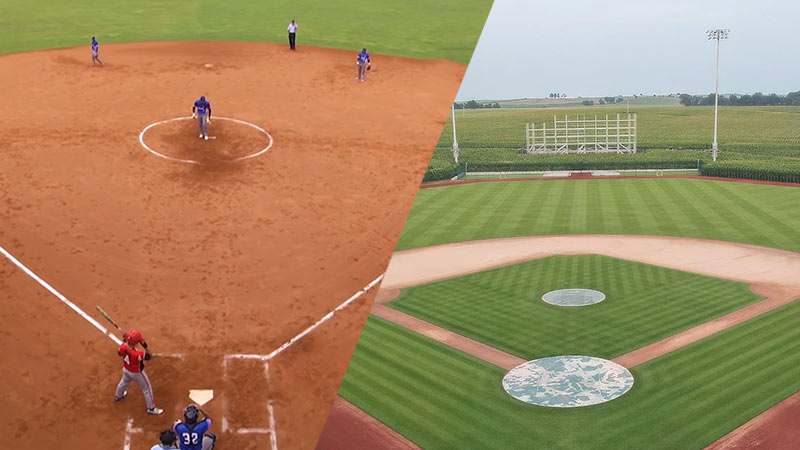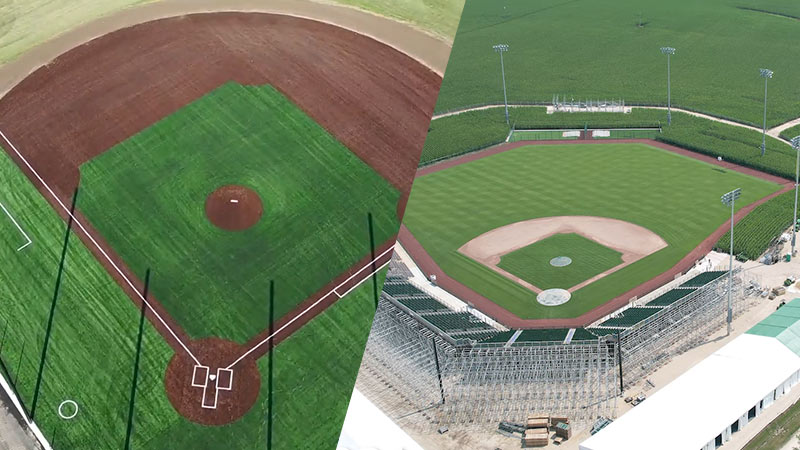When it comes to the world of diamond sports, softball, and baseball are two of the most popular and beloved games.
While they share similarities in terms of gameplay and strategy, one notable difference lies in the fields themselves.
Softball fields and baseball fields may look similar at first glance, but there are specific variations that set them apart.
In this article, we will delve into the contrasting features of softball fields and baseball fields, examining their dimensions, player counts, and other crucial factors.
So, let’s step onto the field and explore the unique characteristics of each sport’s playing surface. Stay focused.
What Is a Softball Field?
A softball field is a specially designed playing surface that accommodates the game of softball. It features a diamond-shaped infield and an outfield, just like a baseball field.
However, there are some differences in the dimensions and layout of a softball field compared to a baseball field.
Infield Size
The dimensions of a softball infield are typically smaller than those of a baseball infield. The distance between bases in softball is 60 feet, while in baseball, it is 90 feet.
The smaller infield size in softball allows for a faster-paced game with quicker defensive plays and base running.
Pitcher’s Mound
The pitcher’s mound in softball is positioned at a distance of 43 feet from home plate, whereas in baseball, it is 60 feet and 6 inches away.
The shorter distance in softball allows for a shorter reaction time for batters, making the game more challenging and requiring quick decision-making.
Outfield Size
The outfield dimensions in softball are generally similar to those in baseball, with the outfield fence serving as the boundary. However, some softball fields may have shorter fences, as the ball is typically hit with less power than in baseball.
Playing Surface
Softball fields can have a variety of playing surfaces, including natural grass, artificial turf, or a combination of both. The choice of playing surface may vary depending on factors such as climate, maintenance requirements, and level of play.
Dugouts and Field Layout
Softball fields feature dugouts on both sides of the field for teams to sit and prepare. The layout and positioning of the dugouts may differ from baseball fields, but they generally provide a designated area for players, coaches, and equipment.
What Is a Baseball Field?
Similarly, a baseball field is the designated playing area for the game of baseball. It consists of a diamond-shaped infield and an outfield. However, baseball fields have their own specific dimensions and layout considerations.
Infield Size
As mentioned earlier, the distance between bases in baseball is 90 feet, significantly larger than in softball. The larger infield size allows for more room for defensive plays and base running, making the game unique in its strategic and tactical elements.
Pitcher’s Mound
In baseball, the pitcher’s mound is situated 60 feet and 6 inches away from home plate. The longer distance gives batters more time to react to the pitch and adjust their swings accordingly.
Outfield Size
Baseball outfield dimensions can vary depending on the specific field, but they are generally more spacious compared to softball fields. This allows for long hits and home runs to be more achievable in the game.
Playing Surface
Baseball fields traditionally have natural grass surfaces, although some modern stadiums may incorporate artificial turf. The choice of playing surface can impact factors such as ball speed, bounce, and fielding conditions.
Dugouts and Field Layout
Baseball fields have dugouts on both sides of the field, providing shelter and seating for players and coaches.
The positioning of the dugouts may vary, with some fields having dugouts positioned closer to home plate and others further down the baselines.
Softball Field vs Baseball Field

Softball fields and baseball fields may share similarities, but they also have distinct differences that impact gameplay and strategies.
From field dimensions and player positions to pitching distances and outfield fence distances, understanding the variations between these two sports is crucial for players and fans alike.
In this section, we will delve into the contrasting elements of softball fields and baseball fields.
Dimension of the Fields
Softball fields are generally smaller than baseball fields. The overall dimensions, including the outfield size, vary significantly between the two sports.
Softball fields are tailored to the smaller scale of the game, with shorter distances from home plate to the outfield fence.
This difference in field size impacts the defensive strategies and the type of hits that are more likely to result in home runs. Softball players must adjust their hitting and fielding techniques to accommodate the smaller playing area.
Number of Players on the Fields
Softball teams typically have ten players on the field, whereas baseball teams consist of nine players. The additional player in softball often takes the position of a short center fielder, providing extra coverage in the outfield.
This extra player can influence defensive alignments and strategies, as there is more flexibility in positioning outfielders to cover more ground.
Centerfield Distance
In softball, the distance from home plate to the centerfield fence is shorter compared to baseball. This variation affects defensive strategies and the number of ground outfielders that need to cover.
Outfielders in softball may need to adjust their positioning and anticipate different types of hits due to the shorter distance from home plate.
Grass/Dirt Infields
Softball fields often have full dirt infields, whereas baseball fields typically feature a combination of grass and dirt. The choice of infield surface impacts the ball’s speed and the player’s movement on the field.
In softball, the full dirt infield allows for faster ball movement and quicker plays, as the ball doesn’t slow down when it hits the grass.
Basepaths
The basepaths in softball are shorter than in baseball. Softball basepaths measure 60 feet, while baseball basepaths are 90 feet long. The shorter basepaths in softball lead to quicker plays and demand faster running times.
This difference affects the timing and execution of steals, bunts, and other base-running strategies.
Pitching Rubber
The distance between the pitching rubber and home plate also differs between softball and baseball. In softball, the pitching rubber is set at a distance of 43 feet (fastpitch) or 46 feet (slowpitch).
Baseball pitchers, on the other hand, throw from a distance of 60 feet, 6 inches. The difference in pitching distance impacts the reaction time for batters and requires adjustments in timing and swing mechanics.
Backstop
The backstop, which acts as a barrier behind home plate, varies in design between softball and baseball fields. Softball backstops are often closer to the field, allowing for shorter throw distances, while baseball backstops tend to be farther away.
The positioning of the backstop influences defensive strategies, particularly when it comes to plays at home plate and wild pitches.
Outfield Fence Distance
The distance from home plate to the outfield fence varies in both sports. Softball fields typically have shorter outfield distances, as the power generated by batters is generally less compared to baseball.
This variation affects the likelihood of hitting home runs and the strategies employed by outfielders. In softball, outfielders may play shallower to prevent extra-base hits, while in baseball, outfielders often play deeper to defend against long balls.
Bullpens
Baseball fields commonly have separate bullpens for pitchers to warm up, located beyond the outfield fence. Softball fields may not have designated bullpen areas, with pitchers warming up either on the field or in an area adjacent to the dugouts.
The presence or absence of bullpen areas can impact the flow of the game and the logistics of warm-up routines for pitchers.
Field Maintenance
Due to the differences in playing surfaces, the maintenance requirements for softball and baseball fields can vary. The type of grass or dirt used, as well as the specific care and upkeep practices, may differ to ensure optimal playing conditions for each sport.
Groundskeepers and field maintenance personnel must adapt their maintenance routines based on the specific needs of softball and baseball fields.
FAQs
Are the dimensions of a softball field the same for all levels of play?
No, the dimensions of a softball field can vary depending on the level of play and the governing organization. However, there are standard guidelines that outline the recommended dimensions for each component of the field.
Why are there more players on a softball field compared to a baseball field?
The additional player in softball is typically positioned as a short center fielder, providing extra coverage in the outfield. This configuration allows for improved defensive strategies and helps account for the smaller field size.
Does the shorter distance between the pitching rubber and home plate in softball affect the game?
Yes, the shorter pitching distance in softball requires hitters to react more quickly to pitches. It emphasizes the importance of timing and quick decision-making, as hitters have less time to see and adjust to the pitch.
How does the grass/dirt infield difference impact the gameplay?
The choice of infield surface affects the ball’s speed and players’ movements. A full dirt infield, as often seen in softball, can result in faster ball travel and a different style of play compared to the grass and dirt combination found on baseball fields.
Do outfielders in softball and baseball have different responsibilities due to the outfield fence distances?
Yes, the shorter outfield fence distances in softball mean that outfielders need to adjust their positioning and strategies accordingly.
With less ground to cover, outfielders must be prepared for quicker plays and adapt their defensive approach accordingly.
Bottom Line
While softball and baseball share many similarities, their playing fields exhibit distinct differences.
The dimensions, number of players, centerfield distance, grass/dirt infields, basepaths, pitching rubber distance, backstop design, and outfield fence distance all contribute to the unique characteristics of each sport.
These distinctions enhance our appreciation for both games and shed light on the strategies and gameplay specific to softball and baseball.
Whether you’re a fan, player, or coach, recognizing and embracing the disparities between softball fields and baseball fields enriches the experience of these beloved diamond sports. Good luck.







